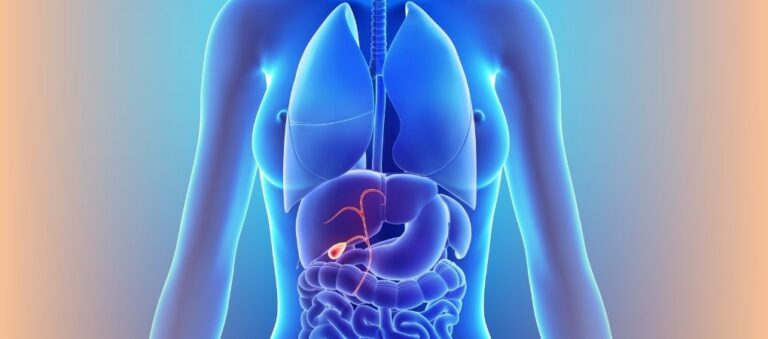Francesca Galiano
|
09/08/2022 - Last update 04/01/2023
Katherine Heineman | Year 2014
Osteopathic manipulative treatment in the management of biliary dyskinesia
Pathology:
Biliary Dyskinesia
Type of study:
Case report
Date of publication of the study’:
2014/Feb/01

Purpose of the study
- Objective: to report the usefulness of OMT in resolving the situation of a patient with biliary dyskinesia symptoms
- Measured outcomes: report of the symptomes
Participants
- Number: 1
- Description: 51-year-old woman, with postprandial pain of the right upper quadrant of the abdomen, which she had had intermittently for 1 year. After meals, the pain radiated into the mid-to-low back and epigastrium. She alternated diarrhea with constipation, and her symptoms would worsen after eating fatty/greasy foods, although she tended to follow a low-fat vegetarian diet.
At the time of onset of symptoms, blood tests (comprehensive metabolic panel) were found to be normal, as well as ultrasound examinations of the gallbladder: no kidney stones or other alterations. The pancreas was also found to be normal, and even several examinations performed in the following months (contrast resonance to assess bile ejection, bile analysis for stones, esophagus-gastroduodenoscopy and colonoscopy) showed no signs of major alterations, other than slight chronic gastritis (but without any sign of Helicobacter pylori).
At the osteopathic examination a medical history of hypothyroidism, seasonal allergies and tension-type headaches emerged, as well as the use of medications or dietary supplements to manage these problems.
The patient denied vomiting, weight loss, hematemesis (blood vomiting), pain or other problems urinating, or incontinence of any kind; she also denied using tobacco, alcohol or drugs.
The vitals were normal, 12 breaths per minute, with BMI of 28.
An osteopathic structural evaluation of the abdomen and spine was carried out, revealing changes at the level of the T6-T9 vertebrae, as well as at the level of the L5 and sacrum. Tissue congestions were also found at the level of the gallbladder, Oddi’s sphincter and at the top of the linea alba.
Interventions and evaluations
OMT with muscle energy techniques directed to the thoracic region and sacrum bone, ligamentous tension balancing and myofascial release techniques to the abdominal and lumbar regions.
Results
The patient received the OMT without any kind of problem or adverse effects.
After OMT, pain in the epigastric and lumbar levels improved.
She was advised to use some supplements (magnesium and digestive enzymes) to reduce nervous irritation and improve digestion, as well as perform specific breathing exercises.
At the follow up visit, 2 weeks after the first examination, the pain in the right upper quadrant of the abdomen was completely gone, as well as the alternation between constipation and diarrhea: the patient began to evacuate regularly and without problems.
The new osteopathic assessment reported an improved overall situation and a new OMT was performed. Advised to return in case of need, the patient did not return.
Discussion
Biliary dyskinesia implies an abnormal contraction of the gallbladder as a result of hormonal and neuronal signals, which can in turn be affected by the state of the organism and its tissues.
The tissue changes found during the osteopathic evaluation at the level of the T6-T9 vertebrae could be linked to an excess of orthosympathetic and nociceptive activation at the fascial level, with the presence of inflammatory substances, excess activation that could have affected the gallbladder inducing dyskinesia and pain.
This excess of activation could result from an particularly fatigued organism due to stressors of various nature with which the organism had come into contact over time.
OMT, thanks to its ability to act on somatic dysfunction and the connected tissue change, has probably helped the patient to reduce that orthosympathetic and nociceptive excessive activation, thus restoring tissue health and the functional state of the gallbladder and the rest of the intestines.
The review of Osteopedia
By Marco Chiera
Strengths: an in-depth description of the patient’s clinical situation; a small review is given on biliary colic at the physiopathological, diagnostic and therapeutic level in the article; OMT may reveal itself to be a useful conservative and non-invasive therapy in case of functional changes in the gallbladder.
Limits: the use of supplements and breathing exercises prevents the understanding of the effective effectiveness of the OMT; in the final comment it is not perfectly clear the nature and role of the somatic dysfunction on which the OMT would act, nor is the concept of allostasis and allostatic load adequately presented.

Are you an osteopath?
Register and enjoy the membership benefits. Create your public profile and publish your studies. It's free!
Register now
School or training institution?
Register and enjoy the membership benefits. Create your public profile and publish your studies. It's free!
Register now
Do you want to become an osteopath? Are you a student?
Register and enjoy the membership benefits. Create your public profile and publish your studies. It's free!
Register now







